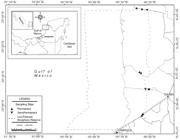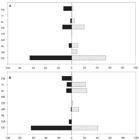We compared fish diet composition between permanent (P) and semi-permanent (SP) pools in Petenes Biosphere Reserve (PBR), Campeche. A total of 445 gut contents were examined to determine stomach relative fullness (RF), fish diet as index of niche breadth (INB) and diet overlap. In SP pools, species showed a RF of 1.66 (57.20 % empty stomachs) whereas in P pools, the RF was 2.91 (31.16%). We classified fish diet into six trophic groups: detritivorous, herbivorous-detritivorous, insectivorous, piscivorous, omnivorous and malacophagous. Species in P pools were found to be specialist. Conversely, species present in both habitats shifted to generalist patterns. There was a 54.0% dissimilarity in fish diet composition between pools. From all items identified, detritus (21.33% of the total dissimilarity), aquatic and terrestrial invertebrates (12.31%), fish remains (10.29%), plant remains (7.37%), and crustaceans (2.74%) distinguished diets between pools. Significant diet overlaps (>0.6) and low INB values (<0.3) were observed in P pools, whereas in SP pools, intermediate-low diet overlaps (<0.4) and higher INB values (>0.5) were observed. In SP pools seasonality had a strong effect on fish diet, increasing the frequency of food items such as terrestrial insects, amphipods and arachnids, during the rainy season while P pools showed lower variation. Thus, fish trophic habits appear to be regulated by pools hydrology.
Campeche; Feeding ecology; Freshwater fish; Mexico; Petenes Biosphere Reserve

 Thumbnail
Thumbnail
 Thumbnail
Thumbnail
 Thumbnail
Thumbnail
 Thumbnail
Thumbnail
 Thumbnail
Thumbnail




